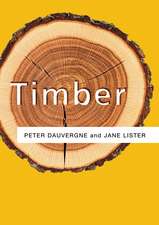Pine Wilt Disease: A Worldwide Threat to Forest Ecosystems
Editat de Manuel M. Mota, Paulo R. Vieiraen Limba Engleză Paperback – 19 oct 2010
| Toate formatele și edițiile | Preț | Express |
|---|---|---|
| Paperback (1) | 1386.17 lei 6-8 săpt. | |
| SPRINGER NETHERLANDS – 19 oct 2010 | 1386.17 lei 6-8 săpt. | |
| Hardback (1) | 1392.33 lei 6-8 săpt. | |
| SPRINGER NETHERLANDS – 12 sep 2008 | 1392.33 lei 6-8 săpt. |
Preț: 1386.17 lei
Preț vechi: 1690.45 lei
-18% Nou
Puncte Express: 2079
Preț estimativ în valută:
265.26€ • 278.92$ • 219.17£
265.26€ • 278.92$ • 219.17£
Carte tipărită la comandă
Livrare economică 17 aprilie-01 mai
Preluare comenzi: 021 569.72.76
Specificații
ISBN-13: 9789048178865
ISBN-10: 904817886X
Pagini: 424
Ilustrații: XVIII, 405 p.
Dimensiuni: 155 x 235 x 22 mm
Greutate: 0.59 kg
Ediția:Softcover reprint of hardcover 1st ed. 2008
Editura: SPRINGER NETHERLANDS
Colecția Springer
Locul publicării:Dordrecht, Netherlands
ISBN-10: 904817886X
Pagini: 424
Ilustrații: XVIII, 405 p.
Dimensiuni: 155 x 235 x 22 mm
Greutate: 0.59 kg
Ediția:Softcover reprint of hardcover 1st ed. 2008
Editura: SPRINGER NETHERLANDS
Colecția Springer
Locul publicării:Dordrecht, Netherlands
Public țintă
ResearchCuprins
Pine Wilt Disease: Global Issues, Trade and Economic Impact.- National Eradication Programme for the Pinewood Nematode.- Incursion Management in the Face of Multiple Uncertainties: A Case Study of an Unidentified Nematode Associated with Dying Pines Near Melbourne, Australia.- The Risk of Pine Wilt Disease to Australia and New Zealand.- Pine Wilt Disease: A Threat to Pine Forests in Turkey?.- Investigations on Wood–Inhabiting Nematodes of the Genus Bursaphelenchus in Pine Forests in the Brandenburg Province, Germany.- Official Survey for Bursaphelenchus xylophilus Carried out on the Territory of the Republic of Poland.- Bursaphelenchus spp. in Wood Packaging Intercepted in China.- Biology and Microbial Inter-Relationships.- Developmental Biology and Cytogenetics of Bursaphelenchus xylophilus.- The Relationship Between the Pinewood Nematode (PWN) and Fungi Cohabiting in aine Trees Inoculated with the PWN.- Influence of Fungi on Multiplication and Distribution of the Pinewood Nematode.- PWN Taxonomy and Detection Methods.- Electronic Taxonomic Databases for Bursaphelenchus and Other Aphelenchid Nematodes.- The Enlargement of the xylophilus Group in the Genus Bursaphelenchus.- Variation in ITS and 28S rDNA of Bursaphelenchus Species (Nematoda: Parasitaphelenchidae).- Molecular Characterization of Isolates of the Bursaphelenchus sexdentati Group Using Ribosomal DNA Sequences and ITS-RFLP.- Analysis of Bursaphelenchus xylophilus (Nematoda: Parasitaphelenchidae) Provenances Using ISSR and RAPD Fingerprints.- Satellite DNA as a Versatile Genetic Marker for Bursaphelenchus xylophilus.- Application of Conventional PCR and Real-Time PCR Diagnostic Methods for Detection of the PineWood Nematode, Bursaphelenchus xylophilus, in Wood Samples from Lodgepole Pine.- The InsectVectors: Biology and Ecology.- Biology Studies Relevant to the Vector Role of Monochamus Species for PineWood Nematode.- Potential Insect Vectors of Bursaphelenchus spp. (Nematoda: Parasitaphelenchidae) in Spanish Pine Forests.- Genetic Structure of Monochamus alternatus in Japan.- Distribution of Nematodes (Bursaphelenchus xylophilus) in the Beetle Monochamus alternatus and its Exiting Transmission Way.- Ecology and Modeling.- Modeling PWN-Induced Wilt Expression: A Mechanistic Approach.- Field Diagnosis of the Asymptomatic Carrier of Pinewood Nematode.- The Tree: Physiology, Resistance and Histopathology as a Result of Pine Wilt Disease.- Inoculation of Pine Trees with Avirulent Pinewood Nematode Under Experimental Conditions: Risk-Benefit Analysis.- Rapidity of Disease Development Seems to Result in High Mortality – Insight from an Inoculation Test Using Hybridized Populations Between a Virulent and an Avirulent Isolates of Bursaphelenchus xylophilus.- Defense Systems of Pinus densiflora Cultivars Selected as Resistant to Pine Wilt Disease.- Histopathological Observations of Bursaphelenchus xylophilus in Symptomatic Tissues of Pinewood.- Development of External and Internal Symptoms in Pine Seedlings (Pinus sylvestris) Due to Inoculation with Bursaphelenchus vallesianus.- Pinewood Nematode and Insect Vector Control Methods.- Screening and Isolation of Anti-Nematodal Metabolites Against Bursaphelenchus xylophilus Produced by Fungi and Plant.- Microbial Control of Bursaphelenchus xylophilus by Fungi.- Attraction Trap for Monitoring Monochamus alternatus Adults – Its Usefulness and Limitations.- Studies on Scleroderma guani to Control the Pine Sawyer Beetle, Monochamus alternatus.- Effect of Aerial Spraying of Insecticide as a Control Measure for Pine WiltDisease.- Control Program of Pine Wilt Disease for Landscape Conservation – The Case of Amanohashidate, Kyoto, Japan.
Recenzii
From the reviews:
"This volume … focused on a variety of topics relevant to PWD, including the threat to forest ecosystems, a summary of the current state of PWD research and insights into future scientific developments. … the coverage of this book is comprehensive, each chapter providing an interesting and authoritative account of the current developments in PWD research. … this is a useful, reasonably up-to-date and competently executed volume that justifies a niche on the shelf of all those involved in the PWD arena." (David J. Hunt, Nematology, Vol. 11 (2), 2009)
"This volume … focused on a variety of topics relevant to PWD, including the threat to forest ecosystems, a summary of the current state of PWD research and insights into future scientific developments. … the coverage of this book is comprehensive, each chapter providing an interesting and authoritative account of the current developments in PWD research. … this is a useful, reasonably up-to-date and competently executed volume that justifies a niche on the shelf of all those involved in the PWD arena." (David J. Hunt, Nematology, Vol. 11 (2), 2009)
Textul de pe ultima copertă
The pinewood nematode (PWN), Bursaphelenchus xylophilus, the causal agent of pine wilt disease (PWD), is a serious pest and pathogen of forest tree species, in particular among the genus Pinus. It was first reported from Japan in the beginning of the XXth century, where it became the major ecological catastrophe of pine forests, with losses reaching over 2 million m3/ year in the 1980s. It has since then spread to other Asian countries such as China, Taiwan and Korea, causing serious losses and economic damage. In 1999, the PWN was first detected in the European Union (EU), in Portugal, and immmediately prompted several government (national and EU) actions to assess the extent of the nematode’s presence, and to contain B. xylophilus and its insect vector (Monochamus galloprovincialis) to an area with a 30km radius in the Setúbal Peninsula, 20 km south of Lisbon. International wood trade, with its political as well as economic ramifications, has been seriously jeopardized. The origin of the population of PWN found in Portugal remains elusive. Several hypotheses may be considered regarding pathway analysis, basically from two general origins: North America or the Far East (Japan or China). World trade of wood products such as timber, wooden crates, palettes, etc… play an important role in the potential dissemination of the pinewood nematode. In fact, human activities involving the movement of wood products may be considered the single most important factor in spreading of the PWN. Despite the dedicated and concerted actions of government agencies, this disease continues to spread. Very recently (2006), in Portugal, forestry and phytosanitary authorities (DGRF and DGPC) have announced a new strategy for the control and ultimately the erradication of the nematode, under the coordination of the national program for the control of the pinewood nematode (PROLUNP). Research regarding the bioecology of the nematode and insect as well as new detection methods, e.g.,involving real-time PCR, has progressed since 1999. International agreements (GATT, WTO) and sharing of scientific information is of paramount importance to effectively control the nematode and its vector, and thus protect our forest ecosystems and forest economy.
Caracteristici
Highly relevant subject, especially in Europe, in light of the recent discovery of one of the most dangerous pathogens and pests of pine forests Highly inter-disciplinary text, covering all issues pertaining to pine wilt disease, from molecule to ecosystem, from the nematode to the insect vector, from forest ecology to plant physiology, etc. Also deals with trade and political issues which becomes useful for decision-makers







